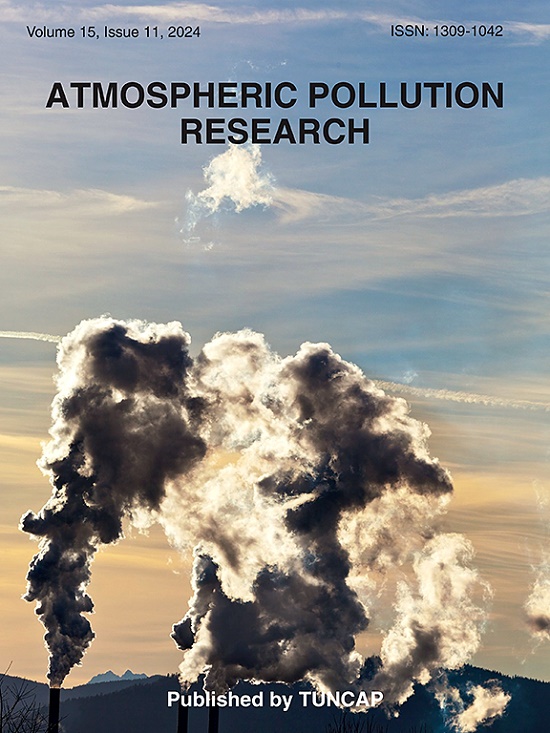Emission inventory and distribution characteristics of NH3 from agricultural fertilizers in Hunan, China, from 2012 to 2021
IF 3.9
3区 环境科学与生态学
Q2 ENVIRONMENTAL SCIENCES
引用次数: 0
Abstract
Fertilization is the main source of NH3 emissions from agricultural ecosystems. Based on fertilization activity data and NH3 emission factors, we aimed to develop an NH3 emission inventory for fertilization in Hunan Province from 2012 to 2021. Additionally, we analyzed the historical trends in, spatial distributions of, and contributions of various districts and counties to NH3 emissions in Hunan. The results showed that the highest emissions were estimated to be 112.69 Gg in 2012, which decreased to 84.11 Gg in 2021, with an average annual decline rate of approximately 3.17%. Additionally, NH3 emissions from paddy fields were greater than those from drylands, and NH3 emissions from nitrogen fertilizer were greater than those from compound fertilizer. During the study period, the NH3 emission intensity of fertilization remained below 0.5 t km−2 in Hunan Province. The areas with greater NH3 emissions were mainly distributed in the northern, northeastern, and central regions. The cities with high emissions mainly included Changde, Hengyang, Yueyang, and Yongzhou. Zhangjiajie had the lowest NH3 emissions and emission intensity in Hunan Province. Hanshou and Anxiang counties had substantial contributions to NH3 emissions in Changde, with contribution rates of 17.86–19.1% and 18.9–19.24%, respectively. Huarong County had the greatest contribution to NH3 emissions in Yueyang, with a contribution rate of 21.49–24.35%; Hengnan County had the greatest contribution to those in Hengyang, with a contribution rate of 20.38–23.62%; and Nan County had the largest contribution to those in Yiyang, with a contribution rate of 33.58–35.36%.
2012 - 2021年湖南省农用肥料NH3排放清查及分布特征
施肥是农业生态系统NH3排放的主要来源。基于施肥活动数据和NH3排放因子,建立2012 - 2021年湖南省施肥NH3排放清单。此外,还分析了湖南省各区县NH3排放的历史趋势、空间分布及其贡献。结果表明,2012年估算排放量最高,为112.69 Gg, 2021年减少至84.11 Gg,年平均下降率约为3.17%。水田NH3排放量大于旱地,氮肥NH3排放量大于复混肥。研究期间,湖南省施肥NH3排放强度保持在0.5 t km−2以下。NH3排放量较大的地区主要分布在北部、东北部和中部地区。高排放城市主要有常德、衡阳、岳阳和永州。湖南省NH3排放量和排放强度最低的是张家界。汉寿县和安乡县对常德市NH3排放贡献较大,贡献率分别为17.86 ~ 19.1%和18.9 ~ 19.24%。华荣县对岳阳市NH3排放的贡献率最大,为21.49 ~ 24.35%;衡阳的贡献率最大的是衡南县,贡献率为20.38 ~ 23.62%;南县对益阳的贡献率最大,为33.58 ~ 35.36%。
本文章由计算机程序翻译,如有差异,请以英文原文为准。
求助全文
约1分钟内获得全文
求助全文
来源期刊

Atmospheric Pollution Research
ENVIRONMENTAL SCIENCES-
CiteScore
8.30
自引率
6.70%
发文量
256
审稿时长
36 days
期刊介绍:
Atmospheric Pollution Research (APR) is an international journal designed for the publication of articles on air pollution. Papers should present novel experimental results, theory and modeling of air pollution on local, regional, or global scales. Areas covered are research on inorganic, organic, and persistent organic air pollutants, air quality monitoring, air quality management, atmospheric dispersion and transport, air-surface (soil, water, and vegetation) exchange of pollutants, dry and wet deposition, indoor air quality, exposure assessment, health effects, satellite measurements, natural emissions, atmospheric chemistry, greenhouse gases, and effects on climate change.
 求助内容:
求助内容: 应助结果提醒方式:
应助结果提醒方式:


